A Summer Tour today, followed by a Nightjar Evening. We were lucky with the weather – mostly bright & sunny and we avoided any showers. We spent the morning inland looking for Birds of Prey, the afternoon looking for waders at Titchwell, and the evening looking for owls and Nightjars.
We saw our first raptors already from the car, as we made our way inland away from the coast. A Common Buzzard flew low over the road and disappeared over the hedge the other side. A couple of Kestrels were perched on the wires as we drove along. Some large flocks of corvids, Rooks and Jackdaws, were gathered in the stubble fields making the most of whatever the harvesters had left behind.
We parked by a farm track and started to walk up it. As we passed a gateway, a Sparrowhawk flushed from a telegraph post on the edge of a field and flew away in a typical burst of flapping followed by a long glide. A Yellowhammer sang from the wires and let us get quite close today, a bright yellow-headed male. A Common Whitethroat darted in and out of the hedge as we walked along and a Song Thrush flew along ahead of us. A flock of tits making their way through the bushes had a Blackcap or two to accompany them.
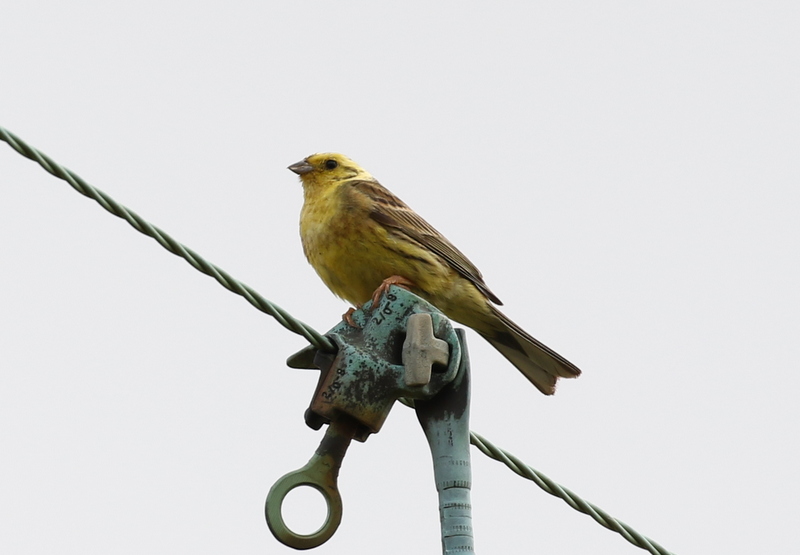 Yellowhammer – singing from the wires
Yellowhammer – singing from the wires
The overgrown verges and hedges either side of the track were alive with butterflies. There were lots of newly emerged Red Admirals, really fresh at the moment and looking very smart. Several Painted Ladys included one which posed nicely for the cameras. The Ringlets are looking a bit tatty and faded now, but there was no shortage of Gatekeepers and a few Commas too. The only skipper which stopped long enough to be formally identified was a Small Skipper.
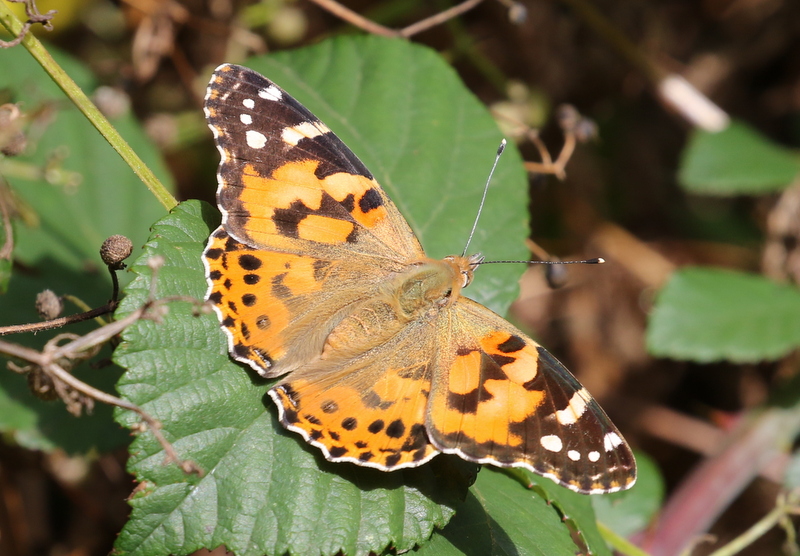 Painted Lady – looking very smart in the sunshine
Painted Lady – looking very smart in the sunshine
Up on slightly higher ground, we stopped at a convenient place with a good vista over the surrounding countryside. As usual, there was a nice selection of birds of prey on show from here. We could hear Common Buzzards calling from the trees behind us and as it warmed up they started to circle up. A Kestrel hovered over the field in front of us. A juvenile Marsh Harrier quartered slowly over but was quickly seen off by the resident raptors.
After a while watching from here, we had a walk on down the back and then followed a footpath round the fields. A couple of Skylarks came up from the weedy margin of a field. We could hear the begging call of a juvenile Kestrel and turned to see the youngster chasing its parent across in front of a line of trees, presumably asking for food. A Stock Dove perched on the top of a barn roof. Swallows and House Martins hawked for insects overhead and a Greenfinch wheezed from the trees. A Great Spotted Woodpecker flew over calling.
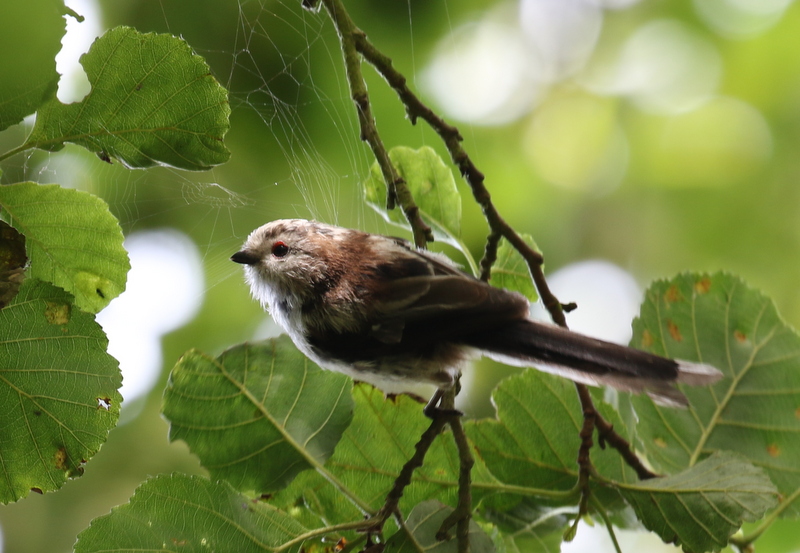 Long-tailed Tit – calling overhead as we ate our lunch
Long-tailed Tit – calling overhead as we ate our lunch
Our next stop today was Titchwell. We arrived just in time for an early lunch, so made our way over to the picnic area. A couple of Speckled Wood butterflies chased each other in the dappled sunshine. A flock of Long-tailed Tits worked their way through the trees overhead as we ate.
After lunch, we walked out along main path. The grazing marsh ‘pool’ is now very dry and largely birdless (1 Lapwing, 1 Black-headed Gull, 1 Woodpigeon!) – a sorry sight. There was a lot more action on the reedbed pool. A single female Red-crested Pochard was out in the middle, we could see her dark cap, pale cheeks and pale-tipped black bill. There was a nice selection of other ducks too – Gadwall, Teal, Shoveler, Common Pochard and a couple of juvenile Tufted Ducks.
As we were walking up towards Island Hide, we could hear Bearded Tits calling, but couldn’t see them from here. We could see a dozen Spoonbills out on the edge of one of the islands and, as usual, they were mostly asleep. Occasionally one would lift its head and flash its spoon-shaped bill. Lurking down on the mud at the front, we could see two very well camouflaged Little Ringed Plovers with alone Dunlin.
 Spoonbills – twelve today, mostly asleep as usual
Spoonbills – twelve today, mostly asleep as usual
From the comfort of Island Hide, we scanned the freshmarsh for waders.There are no shortage of them at Titchwell at the moment – vast throngs of Black-tailed Godwits and Avocets, around 400 of each in recent counts. In amongst them are a fair number of moulting Ruff. A line of godwits out in the middle were Bar-tailed Godwits, some males still mostly in summer plumage with bright rusty underparts right down onto the belly. They had come to roost here over high tide out on the beach, along with a couple of Turnstones.
 Avocet – almost 400 are at Titchwell at the moment
Avocet – almost 400 are at Titchwell at the moment
As well as the larger waders, there were several flocks of Dunlin scattered round the edges of the islands. Most are adults still with their summer black belly patches, but numbers of streaky-bellied juveniles are steadily increasing now. In on of the groups of feeding Dunlin, we found the Little Stint, noticeably smaller, short billed, and clean white below.
There appeared to be no sign of any Curlew Sandpipers at first, but a careful look though a large flock of roosting Dunlin over with the Bar-tailed Godwits revealed a little patch of deep rusty colour in the middle of the throng. As the flock of Dunlin shuffled, the birds either side eventually parted to reveal two moulting adult Curlew Sandpipers, their orange underparts now liberally specked with white. One then woke up, flew over to the mud and started feeding so we could get a better look at it.
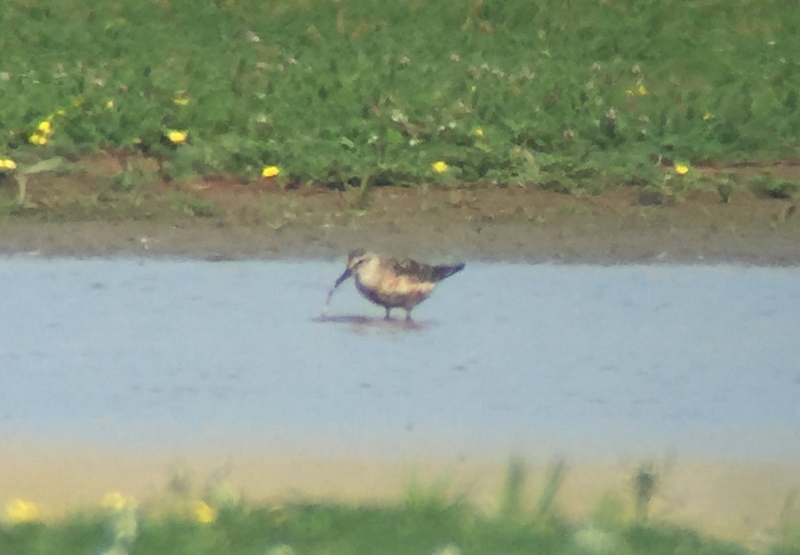 Curlew Sandpiper – one of two moulting adults today
Curlew Sandpiper – one of two moulting adults today
The Bearded Tits were proving frustrating. The reeds are now too tall at one end of the hide to see their favoured edge of the reedbed and they didn’t seem to keen to work their way along and into view today. Another two Bearded Tits were calling from the reeds right in front of the other end of the hide, also out of view, and then flew right across in front of the hide and disappeared deep into the main reedbed. A very tatty adult Marsh Harrier, worn out after the rigours of the breeding season, drifted across the reeds.
Another birder arriving in the hide let us know that the Bearded Tits were showing from the main path just outside, so we walked up the slope and immediately spotted a juvenile Bearded Tit on the edge of the reeds below us. This time we got a good view of it, as it hopped around on the mud.
Round at Parrinder Hide, it didn’t take long to find the Spotted Redshanks, hiding in the far corner as usual. We could only see five from here, but they kept disappearing from view behind the islands. A single Golden Plover, still in black-bellied summer plumage, was hiding behind the fence on the island. A gaggle of noisy Greylags were hanging around right in front of the hide, but a smart Black-tailed Godwit was lurking in with them, very close where we could get a great look at it.
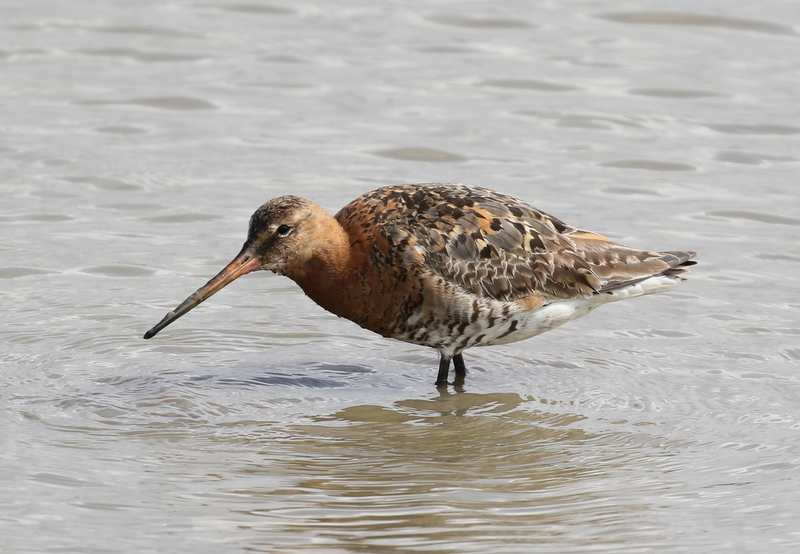 Black-tailed Godwit – in front of Parrinder Hide
Black-tailed Godwit – in front of Parrinder Hide
We had a quick look in at the Volunteer Marsh and the tidal pools, but there was very little on either, mainly a few roosting Curlews. Out at the beach, the tide was in. The sea was more productive, with a raft raft of about 30 Common Scoter offshore and a couple of other lone ones closer in. A Great Crested Grebe was also out on the water and a distant Gannet flew slowly east.
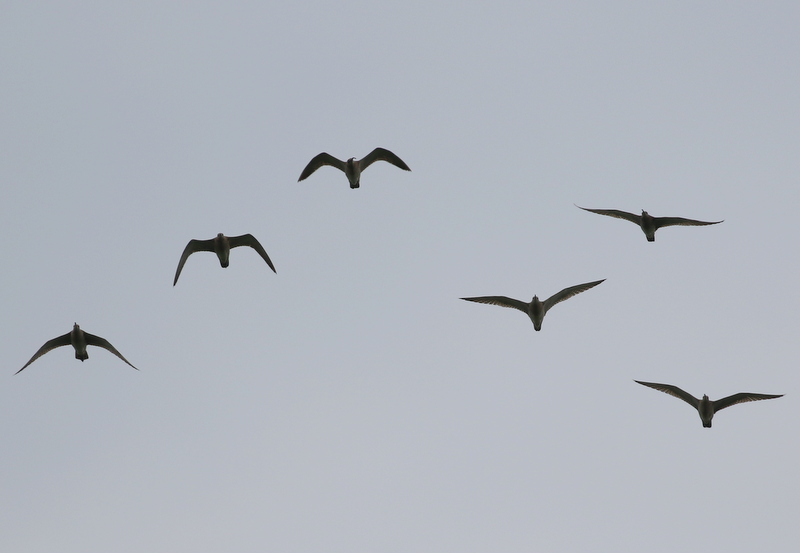 Whimbrel – these six flew off west at the end of the day
Whimbrel – these six flew off west at the end of the day
As we made our way way back past the Volunteer Marsh, we heard a Whimbrel call. We looked over to see two come up from the marsh. As they circled over calling, more Whimbrel flew up, one at a time until we could see six of them circling over together. They appeared to go down towards the freshmarsh, but later on as we were walking back past they reedbed they flew overhead in a tight flock, disappearing away to the west.
As we passed the freshmarsh, a moulting Ruff was feeding close by the main path.
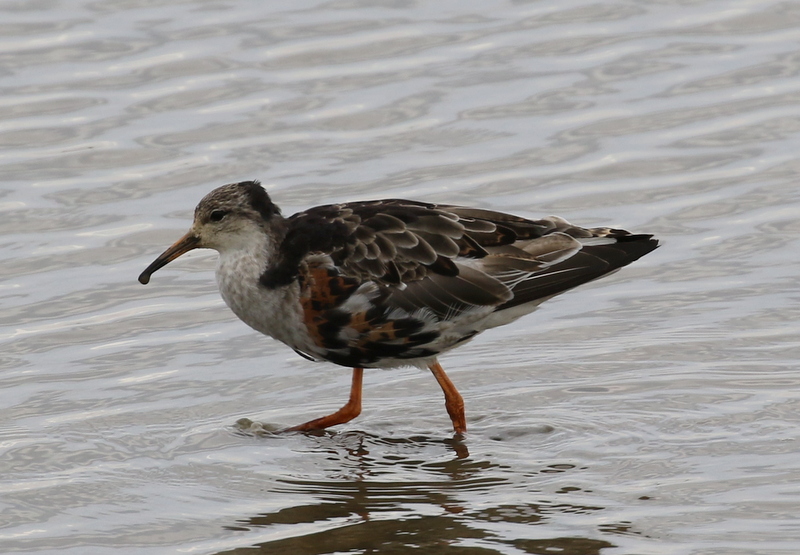 Ruff – still with some rusty & black summer feathers
Ruff – still with some rusty & black summer feathers
We took a detour round via Meadow Trail on the way back and out to Patsy’s Reedbed. A couple of Little Grebes on the pool were an addition to the day’s list, and there were still some small juvenile Avocets on the islands, but nothing else out of the ordinary today.
The Autumn Trail has only recently opened this year, so we walked round to take a look at the back of the freshmarsh. Now we could see the Spotted Redshanks properly and found there were actually ten of them lurking mostly out of view from the other hides. The majority of them are now mostly in silvery grey/white winter plumage, but one was still liberally blotched with black underneath.
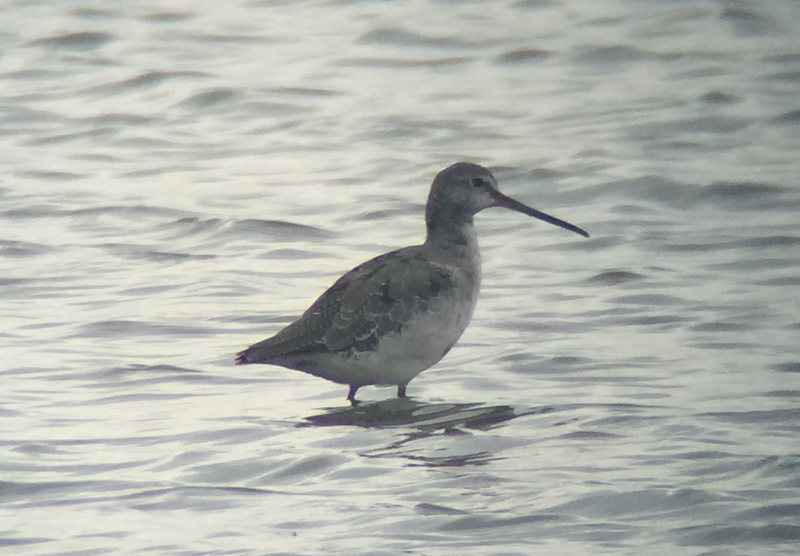 Spotted Redshank – mostly in winter plumage now
Spotted Redshank – mostly in winter plumage now
Then, with a busy evening ahead of us, it was time to call it a day and head back to the car.
Nightjar Evening
After a break for a rest and to get something to eat, we met again later on for the Nightjar Evening. With a bit of time before sunset, we went looking for owls first. At our first stop, the Little Owls performed well again. One was perched up rather distantly when we arrived, a good start, but it flew away out of sight fairly quickly.
We waited for a few minutes and then a second Little Owl appeared much closer to us on the roof of an old barn. It sat in full view looking around for a minute or so, then disappeared inside. Shortly after, it reappeared and gave great views, first on the roof and then flying up and perching in the evening sunshine. Another Little Owl was calling further over behind it.
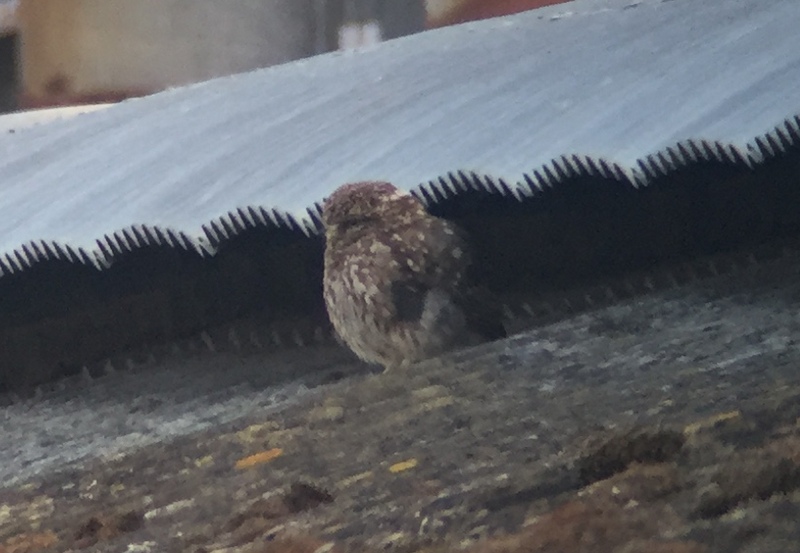 Little Owl – appeared on the barn roof at dusk
Little Owl – appeared on the barn roof at dusk
With the evenings already drawing in, we did not have so much time to look for Barn Owls. They have been coming out very late this year anyway, perhaps reflective of a poor breeding season and a distinct lack of voles. We drove round some regular hunting areas and had a quick walk out to the place we normally see them.
There was a beautiful sunset away to the west. A couple of tight flocks of Swifts came screaming overhead, chasing each other in circles. But there was no sign of any Barn Owls out yet. We didn’t want to be late for the main event, so decided to head up to the Heath in good time rather than hang around any longer.
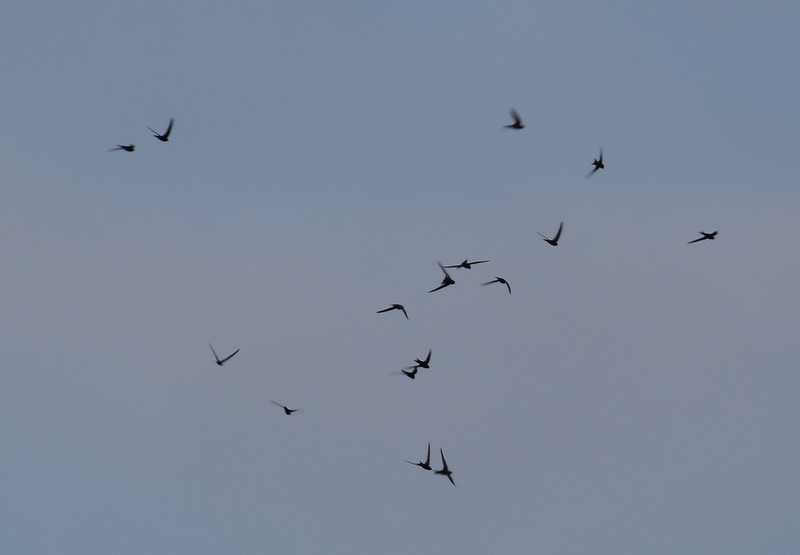 Swifts – screaming overhead late this evening
Swifts – screaming overhead late this evening
Up at the heath, we did not have to wait long before the first Nightjar started churring. It churred and called intermittently at first, from the safety of its roost site. The as the light started to fade, they started to fly around. The first Nightjar we saw flew up high against the sky, silhouetted above the trees. Another then flew in towards us and right past, possibly a female as it appeared to lack the white in the wings shown by the male. The resident (where we were standing) male Nightjar then flew across along the edge of the trees, flashing his white wing and tail patches. Another male circled low around an oak tree further over.
All the time, we could hear the males churring, at least three separate males within immediate earshot, not least because we had positioned ourselves along the boundary for two territories. As the Nightjars flew round we could hear their loud ‘koo-wick’ calls and even the wing clapping of the males. Just as it was getting dark, one of the male Nightjars flew up and landed on a dead branch sticking out of the very top of an oak tree. It was a really evocative sight to see it perched there, silhouetted against the deep blue night sky, churrring into the gathering gloom.
As the dark descended, we made our way back to the car, serenaded by the churring of Nightjars.
















